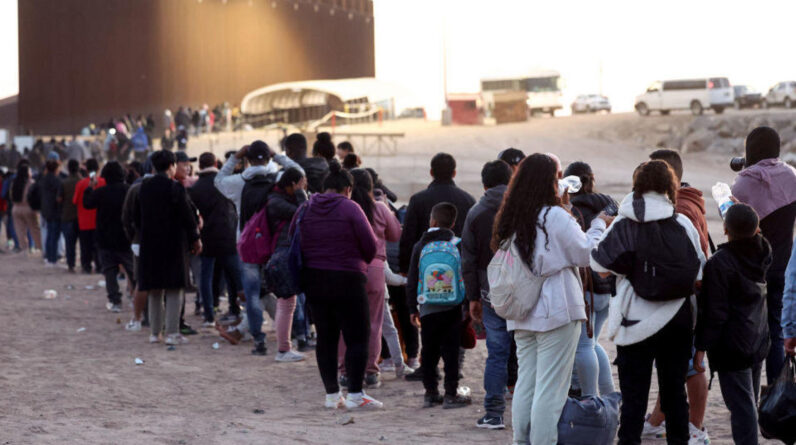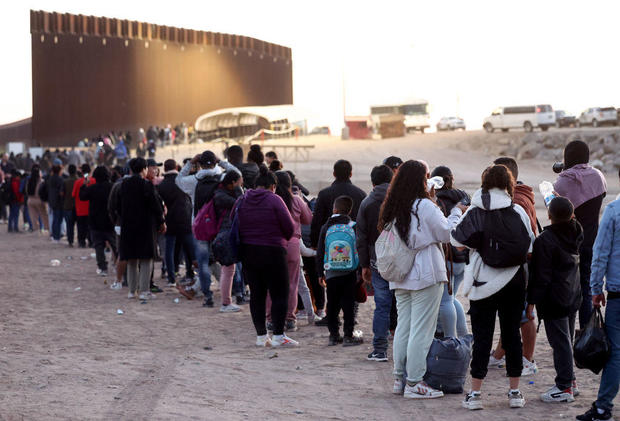
El Paso, Texas – An estimated 60,000 migrants were waiting near the US-Mexico border when the Biden administration ended Title 42 Pandemic Era Rule that has allowed authorities to deport those entering the country illegally, a senior US official told CBS News on Thursday.
Border Patrol Chief Raul Ortiz said his agency was preparing for some of the tens of thousands of migrants currently on the Mexican side of the US-Mexico border to try to cross into the US. Title 42 has expired Thursday at midnight.
“More than 60,000 migrants that we project are staged in and around the immediate border area,” Ortiz said in an interview earlier in the day in El Paso. “So we’re focused on making sure we’re doing everything we can to allocate resources to address those flows.”
In the run-up to the end of Title 42, which was triggered by the expiration of the national public health emergency COVID-19, border officials have already seen an increase in migration, recording about 10,000 apprehensions a day on some days of ‘this week.
On Thursday, nearly 25,000 migrants were in Border Patrol facilities and tents, Ortiz said, although the agency only had paper capacity to accommodate several thousand people.
Ortiz said the Border Patrol is working to reduce overcrowding in its detention facilities by quickly releasing some migrants without court dates.
“We are over capacity in several of the sectors,” Ortiz said. “And so we’re working closely with our partner NGOs, our communities to make sure that we release these migrants after they’ve been vetted and cleared, and that they don’t pose a significant threat to the community.”
Mario Tama/Getty Images
Ortiz attributed the current increase in border arrivals to smugglers who “force some migrants to make some decisions that they probably shouldn’t make” by spreading misinformation about US policy, including on social media.
Despite the current challenges, Ortiz said he doesn’t foresee a “big increase” in migrant crossings immediately after Title 42 ends.
Ortiz noted that the Title 42 transition will not be abrupt, noting that as of Wednesday, only 19 percent of detained migrants were being processed for removal under the public health order.
He also said the government hopes to deter illegal crossings by deporting or returning migrants who do not qualify for asylum and prosecuting repeat crossers.
In fact, the Biden administration has made it harder for migrants to get asylum after Title 42.
Under a rule implemented Friday, migrants who cross the southern border without permission will not be eligible for asylum unless they seek protection in another country, such as Mexico, on their way to the US.
Those who cannot prove they qualify for an exemption from the rule face deportation to their home country or Mexico, as well as a 5-year banishment from the US.
The ACLU and other groups challenged the new rule in federal court Thursday afternoonbut the Department of Homeland Security defended it, saying in a statement that it is “intended to incentivize migrants to use legal pathways instead of making the dangerous journey to cross the southern border illegally. This rule responds to the heightened encounters we are experiencing at the border and is critical to creating an orderly process for seeking protection in the United States at a time when Congress refuses to reform our broken immigration laws or provide the funds needed to hire enough asylum officers and judges “immigration to process claims in a timely manner.”
The Biden administration is combining tougher asylum rules with more opportunities for migrants to enter the country legally, including through an application for asylum seekers in Mexico and a program for Cubans, Nicaraguans, Haitians and Venezuelans with American sponsors.
Biden administration officials have said the policies will eventually reduce historically high levels of border arrivals.
However, Homeland Security Secretary Alejandro Mayorkas said the policy changes would mark a “difficult” period for his department. President Biden also said the situation would be “chaotic,” at least for “a while.”
Meanwhile, U.S. Immigration and Customs Enforcement (ICE) also announced Thursday night that it would add “several thousand” beds to its detention centers in response to the expiration of the public health emergency COVID -19. The announcement did not mention the expiration of Title 42.
ICE noted that with the expiration of the public health emergency, it was ending the COVID-19 testing and quarantine requirements for all detainees.
“These changes will increase the number of beds accessible to ICE’s detention network and allow ICE to process noncitizen detainees for admission more quickly,” the agency wrote.
More Camilo Montoya-Galvez
[ad_2]
Source link







